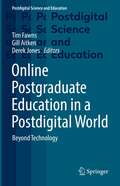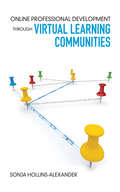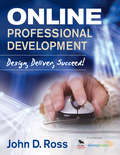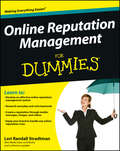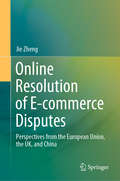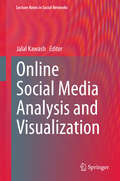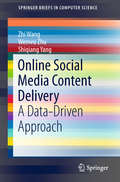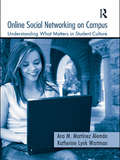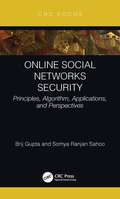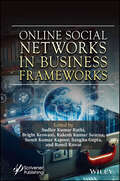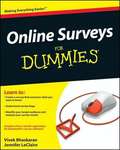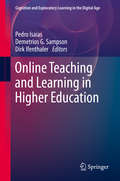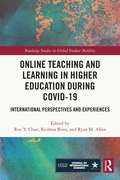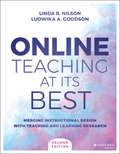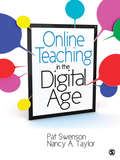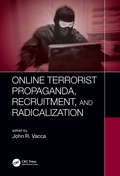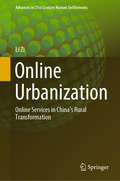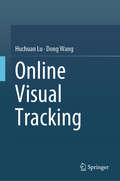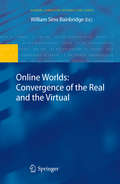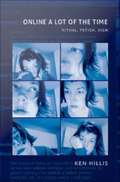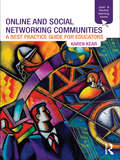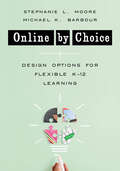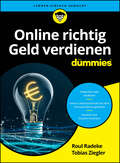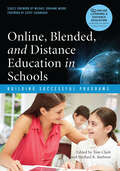- Table View
- List View
Online Postgraduate Education in a Postdigital World: Beyond Technology (Postdigital Science and Education)
by Derek Jones Gill Aitken Tim FawnsThis edited volume builds upon the premise that online learning is not separate from the social and material world, and is made up of embodied, socially-meaningful experiences. It is founded on a “postdigital” perspective in which, much more than interactions with keyboards, computer screens, hardware or software, the learning that happens on online postgraduate programmes spills out into professional and informal settings, making connections with what comes before and after any formally-scheduled tasks. Unlike other books relating to online education, this book combines a theoretical perspective, in which the digital, physical and social are all interconnected within complex educational ecologies, with a focus grounded in postgraduate practice. This focus has important implications for the kinds of students and learning that are explored in the chapters of the book. This book provides an important contribution to the knowledge of what is required to produce quality, online postgraduate programmes at the level of teachers, curriculum designers, faculty developers and policy-makers.
Online Professional Development Through Virtual Learning Communities
by Sonja Hollins-AlexanderCreate a 21st-century professional development program! Can online learning deliver high-caliber professional development (PD) with lower costs? This timely book shows you how, and the answer lies in combining well-designed online instruction with the energy of peer-to-peer collaboration. Sonja Hollins-Alexander writes from her own experience building a successful online professional development program for a large urban district.
Online Professional Development: Design, Deliver, Succeed!
by John D. RossMuch-needed direction for navigating online professional development Online professional development expert John D. Ross’s practical framework will help you ask the right questions and make sound development and purchasing decisions. Based on proven principles of professional learning and instructional design, he guides you through charting your course to success and provides a path to answering these fundamental questions: <p><p> Why do I need OPD? <p> How much does it cost? <p> How do I get started? <p> What does high-quality online learning look like? <p> What technologies are right for me? <p> Did it work?
Online Reputation Management For Dummies
by Lori Randall StradtmanMore important than ever--how to manage your online reputationIn today's social world, managing your online reputation is more critical than ever, whether it's your company brand or yourself as a brand, and one thing is certain: everyone needs a plan. This essential book shows you how to set up a system that works every day, helps forward your brand's online goals, and is able to deal with negative chatter. Covering everyday listening and messaging as well as reputation management for special events or crises, this book walks you through step-by-step instructions and tips that will help you build and maintain a positive online presence.Shows you how to create a solid, productive online reputation management system Helps you achieve your brand's goals and be ready to deal with negative chatter or crises Explains how to set up an online reputation management and response team Covers how to identify and incorporate both everyday and crisis SEO keywords Explores reputation creation through listening, messages, images, video, and other media Helps you handle crises with social media, bloggers, and other influencers, and respond immediately Online Reputation Management For Dummies gives you the tools you need to maintain the online reputation you want.
Online Resolution of E-commerce Disputes: Perspectives from the European Union, the UK, and China
by Jie ZhengThis book discusses how technological innovations have affected the resolution of disputes arising from electronic commerce in the European Union, UK and China. Online dispute resolution (ODR) is a form of alternative dispute resolution in which information technology is used to establish a process that is more effective and conducive to resolving the specific types of dispute for which it was created. This book focuses on out-of-court ODR and the resolution of disputes in the field of electronic commerce. It explores the potential of ODR in this specific e-commerce context and investigates whether the current use of ODR is in line with the principles of access to justice and procedural fairness. Moreover, it examines the major concerns surrounding the development of ODR, e.g. the extent to which electronic ADR agreements are recognized by national courts in cross-border e-commerce transactions, how procedural justice is ensured in ODR proceedings, and whether ODR outcomes can be effectively enforced. To this end, the book assesses the current and potential role of ODR in resolving e-commerce disputes, identifies the legal framework for and legal barriers to the development of ODR, and makes recommendations as to the direction in which practice and the current legal framework should evolve. In closing, the book draws on the latest legislation in the field of e-commerce law and dispute resolution in order to make recommendations for future ODR design, such as the EU Platform-to-Business Regulation on Promoting Fairness and Transparency for Business Users of Online Intermediation Services (2019) and the United Nations Convention on International Settlement Agreements Resulting from Mediation (2018), which provide the legal basis for ODR’s future development.
Online Social Media Analysis and Visualization
by Jalal KawashThis edited volume addresses the vast challenges of adapting Online Social Media (OSM) to developing research methods and applications. The topics cover generating realistic social network topologies, awareness of user activities, topic and trend generation, estimation of user attributes from their social content, behavior detection, mining social content for common trends, identifying and ranking social content sources, building friend-comprehension tools, and many others. Each of the ten chapters tackle one or more of these issues by proposing new analysis methods or new visualization techniques, or both, for famous OSM applications such as Twitter and Facebook. This collection of contributed chapters address these challenges. Online Social Media has become part of the daily lives of hundreds of millions of users generating an immense amount of 'social content'. Addressing the challenges that stem from this wide adaptation of OSM is what makes this book a valuable contribution to the field of social networks.
Online Social Media Content Delivery: A Data-Driven Approach (SpringerBriefs in Computer Science)
by Zhi Wang Wenwu Zhu Shiqiang YangThis book explains how to use a data-driven approach to design strategies for social media content delivery. It first introduces readers to how social information can be effectively gathered for big data analysis, which provides content delivery intelligence. Secondly, the book describes data-driven models to capture information diffusion in online social networks and social media content propagation and popularity, before presenting prediction models for social media content delivery. By addressing the resource allocation and content replication aspects of social media content delivery, the book presents the latest data-driven strategies. In closing, it outlines a number of potential research directions regarding social media content delivery.
Online Social Networking on Campus: Understanding What Matters in Student Culture
by Ana M. Martínez-Alemán Katherine Lynk WartmanIn the era of such online spaces as Facebook, Instant Messenger, Live Journal, Blogger, Web Shots, and campus blogs, college students are using these resources and other online sites as a social medium. Inevitably, this medium presents students with ethical decisions about social propriety, self disclosure and acceptable behaviour. Because online social networking sites have proven problematic for college students and for college administrators, this book aims to offer professional guidance to Higher Education administrators and policy makers. Online Social Networking on Campus: Understanding what matters in student culture is a professional guide for Higher Education faculty and Student Affairs administrators, which rigorously examines college students’ use of online social networking sites and how they use these to develop relationships both on and off campus. Most importantly, Online Social Networking on Campus investigates how college students use online sites to explore and makes sense of their identities. Providing information taken from interviews, surveys and focus group data, the book presents an ethnographic view of social networking that will help Student Affairs administrators, Information Technology administrators, and faculty better understand and provide guidance to the "neomillennials" on their campuses.
Online Social Networks Security: Principles, Algorithm, Applications, and Perspectives
by Brij B. Gupta Somya Ranjan SahooIn recent years, virtual meeting technology has become a part of the everyday lives of more and more people, often with the help of global online social networks (OSNs). These help users to build both social and professional links on a worldwide scale. The sharing of information and opinions are important features of OSNs. Users can describe recent activities and interests, share photos, videos, applications, and much more. The use of OSNs has increased at a rapid rate. Google+, Facebook, Twitter, LinkedIn, Sina Weibo, VKontakte, and Mixi are all OSNs that have become the preferred way of communication for a vast number of daily active users. Users spend substantial amounts of time updating their information, communicating with other users, and browsing one another’s accounts. OSNs obliterate geographical distance and can breach economic barrier. This popularity has made OSNs a fascinating test bed for cyberattacks comprising Cross-Site Scripting, SQL injection, DDoS, phishing, spamming, fake profile, spammer, etc. OSNs security: Principles, Algorithm, Applications, and Perspectives describe various attacks, classifying them, explaining their consequences, and offering. It also highlights some key contributions related to the current defensive approaches. Moreover, it shows how machine-learning and deep-learning methods can mitigate attacks on OSNs. Different technological solutions that have been proposed are also discussed. The topics, methodologies, and outcomes included in this book will help readers learn the importance of incentives in any technical solution to handle attacks against OSNs. The best practices and guidelines will show how to implement various attack-mitigation methodologies.
Online Social Networks in Business Frameworks
by Romil Rawat Sudhir Kumar Rathi Bright Keswani Rakesh Kumar Saxena Sumit Kumar Kapoor Sangita GuptaThis book presents a vital method for companies to connect with potential clients andconsumers in the digital era of Online Social Networks (OSNs), utilizing the strengthof well-known social networks and AI to achieve success through fostering brandsupporters, generating leads, and enhancing customer interactions. There are currently 4.8 billion Online Social Network (OSN) users worldwide. Online Social Networks in Business Frameworks presents marketing through online social networks (OSNs), which is a potent method for companies of all sizes to connect with potential clients and consumers. If visitors are not on OSN sites like Facebook, Twitter, and LinkedIn, they are missing out on the fact that people discover, learn about, follow, and purchase from companies on OSNs. Excellent OSN advertising may help a company achieve amazing success by fostering committed brand supporters and even generating leads and revenue. A type of digital advertising known as social media marketing (SMM) makes use of the strength of well-known social networks to further advertise and establish branding objectives. Nevertheless, it goes beyond simply setting up company accounts and tweeting whenever visitors feel like it. Preserving and improving profiles means posting content that represents the company and draws in the right audience, such as images, videos, articles, and live videos, addressing comments, shares, and likes while keeping an eye on the reputation to create a brand network, and following and interacting with followers, clients, and influencers.
Online Surveys For Dummies
by Vivek Bhaskaran Jennifer LeclaireThe easy way to build effective online surveys for your business, with three months of free service! By targeting select response groups, online surveys are a great way to help your business, group, or organization get valuable feedback quickly. But with over 40 vendors and hundreds of options available, where do you start? This friendly book walks you step by step through the process of creating, launching, and getting results from an online survey. You'll learn about the tools involved, what results to expect, how to build a compelling survey, tips for identifying the right audience, and how to analyze the results. Discover What a survey is and how to put one together Survey lingo and a sample survey to study How to develop questions and assemble them into an attractive, easy-to-use interface that encourages response Tips for identifying and contacting the respondents you want to hear from The steps involved in making a usable analysis of the results Pitfalls to avoid, things to check out before launching a survey, and best practices With the book, you'll also receive three months of free service from a top survey vendor to get you started.
Online Teaching and Learning in Higher Education (Cognition and Exploratory Learning in the Digital Age)
by Dirk Ifenthaler Pedro Isaias Demetrios G. SampsonThis book is to explores a variety of facets of online learning environments to understand how learning occurs and succeeds in digital contexts and what teaching strategies and technologies are most suited to this format. Business, health, government and education are some of the core sectors of society which have been experiencing deep transformations due to a generalized digitalization. While these changes are not novel, the swift progress of technology and the rising complexity of digital environments place a focus on the need for further research and novel strategies. In the context of education, the promise of increased flexibility and broader access to educational resources is impelling much of higher education’s course offerings to online environments. The 21st century learner requires an education that can be pursued anytime and anywhere and that is more aligned with the demands of a digital society. Online education not only assists students to success-fully integrate a workforce that is increasingly digital, but it helps them to become more comfortable with the use of technology in general and, hence, more prepared to be prolific digital citizens. The variety of settings portrayed in this volume attest to the unlimited opportunities afforded by online learning and serve as valuable evidence of its benefit for students’ educational experience. Moreover, these research efforts assist a more comprehensive reflection about the delivery of higher education in the context of online settings.
Online Teaching and Learning in Higher Education during COVID-19: International Perspectives and Experiences (Routledge Studies in Global Student Mobility)
by Krishna Bista Roy Y. Chan Ryan M. AllenThis timely volume documents the immediate, global impacts of the coronavirus pandemic (COVID-19) on teaching and learning in higher education. Focusing on student and faculty experiences of online and distance education, the text provides reflections on novel initiatives, unexpected challenges, and lessons learned. Responding to the urgent need to better understand online teaching and learning during the COVID-19 pandemic, this book investigates how the use of information and communication technologies (ICT) impacted students, faculty, and staff experiences during the COVID-19 lockdown. Chapters initially look at the challenges faced by universities and educators in their attempts to overcome the practical difficulties involved in developing effective online programming and pedagogy. The text then builds on these insights to highlight student experiences and consider issues of social connection and inequality. Finally, the volume looks forward to asking what lessons COVID-19 can offer for the future development of online and distance learning in higher education. This engaging volume will benefit researchers, academics, and educators with an interest in online teaching and eLearning, curriculum design, and more, specifically those involved with the digitalization of higher education. The text will also support further discussion and reflection around pedagogical transformation, international teaching and learning, and educational policy more broadly.
Online Teaching at Its Best: Merging Instructional Design with Teaching and Learning Research
by Linda B. Nilson Ludwika A. GoodsonBring pedagogy and cognitive science to online learning environments Online Teaching at Its Best: Merging Instructional Design with Teaching and Learning Research, 2nd Edition, is the scholarly resource for online learning that faculty, instructional designers, and administrators have raved about. This book addresses course design, teaching, and student motivation across the continuum of online teaching modes—remote, hybrid, hyflex, and fully online—integrating these with pedagogical and cognitive science, and grounding its recommendations in the latest research. The book will help you design or redesign your courses to ensure strong course alignment and effective student learning in any of these teaching modes. Its emphasis on evidence-based practices makes this one of the most scholarly books of its kind on the market today. This new edition features significant new content including more active learning formats for small groups across the online teaching continuum, strategies and tools for scripting and recording effective micro-lectures, ways to integrate quiz items within micro-lectures, more conferencing software and techniques to add interactivity, and a guide for rapid transition from face-to-face to online teaching. You’ll also find updated examples, references, and quotes to reflect more evolved technology. Adopt new pedagogical techniques designed specifically for remote, hybrid, hyflex, and fully online learning environments Ensure strong course alignment and effective student learning for all these modes of instruction Increase student retention, build necessary support structures, and train faculty more effectively Integrate research-based course design and cognitive psychology into graduate or undergraduate programs Distance is no barrier to a great education. Online Teaching at Its Best provides practical, real-world advice grounded in educational and psychological science to help online instructors, instructional designers, and administrators deliver an exceptional learning experience even under emergency conditions.
Online Teaching in the Digital Age
by Patricia Jane Swenson Nancy Annette TaylorThe essential guide to teaching in a virtual environmentOnline Teaching in the Digital Age provides educators with the essential knowledge needed to successfully develop and teach an online course. Throughout this practical hands-on guide, the authors offer 15 years of personal online teaching experience in language accessible to both the novice and advanced online educator. Developed through theory and practice, the text shows educators how to take the materials used in a traditional classroom and transfer them to a new virtual environment. Additionally, it gives educators the confidence and skills needed to run real-time (synchronous) and time-arranged (asynchronous) online discussions. Most reassuring of all, this book shows that few traditional course elements need to change in order to start teaching online.
Online Terrorist Propaganda, Recruitment, and Radicalization
by John R. VaccaOnline Terrorist Propaganda, Recruitment, and Radicalization is most complete treatment of the rapidly growing phenomenon of how terrorists’ online presence is utilized for terrorism funding, communication, and recruitment purposes. The book offers an in-depth coverage of the history and development of online "footprints" to target new converts, broaden their messaging, and increase their influence. Chapters present the emergence of various groups; the advancement of terrorist groups’ online presences; their utilization of video, chat room, and social media; and the current capability for propaganda, training, and recruitment. With contributions from leading experts in the field—including practitioners and terrorism researchers—the coverage moves from general factors to specific groups practices as relate to Islamic State of Iraq and the Levant (ISIL), and numerous other groups. Chapters also examine the lone wolf phenomenon as a part of the disturbing trend of self-radicalization. A functional, real-world approach is used regarding the classification of the means and methods by which an online presence is often utilized to promote and support acts of terrorism. Online Terrorist Propaganda, Recruitment, and Radicalization examines practical solutions in identifying the threat posed by terrorist propaganda and U.S. government efforts to counter it, with a particular focus on ISIS, the Dark Web, national and international measures to identify, thwart, and prosecute terrorist activities online. As such, it will be an invaluable resources for intelligence professionals, terrorism and counterterrorism professionals, those researching terrorism funding, and policy makers looking to restrict the spread of terrorism propaganda online.
Online Urbanization: Online Services in China’s Rural Transformation (Advances in 21st Century Human Settlements)
by Li ZiThis book highlights the new urban–rural relationship that has emerged under the influence of e-commerce in China. In this regard, it presents case studies on the Suichang rural e-commerce model and Alibaba’s rural strategy, together with analyses of online service in China. Furthermore, by means of a brief review of the urban–rural relationship throughout China’s history, and of academic literature on the study of space, it explains the special logic of urbanization in China. As such, the book makes a valuable contribution to the body of literature on the space of flows and grassrooting, aspects that are essential to appreciating the complexity of the new urban–rural relationship in underdeveloped areas (including developing countries and underdeveloped areas in developed countries) in the ongoing information era.
Online Visual Tracking
by Huchuan Lu Dong WangThis book presents the state of the art in online visual tracking, including the motivations, practical algorithms, and experimental evaluations. Visual tracking remains a highly active area of research in Computer Vision and the performance under complex scenarios has substantially improved, driven by the high demand in connection with real-world applications and the recent advances in machine learning. A large variety of new algorithms have been proposed in the literature over the last two decades, with mixed success.Chapters 1 to 6 introduce readers to tracking methods based on online learning algorithms, including sparse representation, dictionary learning, hashing codes, local model, and model fusion. In Chapter 7, visual tracking is formulated as a foreground/background segmentation problem, and tracking methods based on superpixels and end-to-end deep networks are presented. In turn, Chapters 8 and 9 introduce the cutting-edge tracking methods based on correlation filter and deep learning. Chapter 10 summarizes the book and points out potential future research directions for visual tracking. The book is self-contained and suited for all researchers, professionals and postgraduate students working in the fields of computer vision, pattern recognition, and machine learning. It will help these readers grasp the insights provided by cutting-edge research, and benefit from the practical techniques available for designing effective visual tracking algorithms. Further, the source codes or results of most algorithms in the book are provided at an accompanying website.
Online Worlds: Convergence of the Real and the Virtual
by William Sims BainbridgeVirtual worlds are persistent online computer-generated environments where people can interact, whether for work or play, in a manner comparable to the real world. The most popular current example is World of Warcraft, a massively multiplayer online game with eleven million subscribers. However, other virtual worlds, notably Second Life, are not games at all but internet-based collaboration contexts in which people can create virtual objects, simulated architecture, and working groups. This book brings together an international team of highly accomplished authors to examine the phenomena of virtual worlds, using a range of theories and methodologies to discover the principles that are making virtual worlds increasingly popular, and which are establishing them as a major sector of human-centred computing.
Online a Lot of the Time: Ritual, Fetish, Sign
by Ken HillisA wedding ceremony in a Web-based virtual world. Online memorials commemorating the dead. A coffee klatch attended by persons thousands of miles apart via webcams. These are just a few of the ritual practices that have developed and are emerging in online settings. Such Web-based rituals depend on the merging of two modes of communication often held distinct by scholars: the use of a device or mechanism to transmit messages between people across space, and a ritual gathering of people in the same place for the performance of activities intended to generate, maintain, repair, and renew social relations. In Online a Lot of the Time, Ken Hillis explores the stakes when rituals that would formerly have required participants to gather in one physical space are reformulated for the Web. In so doing, he develops a theory of how ritual, fetish, and signification translate to online environments and offer new forms of visual and spatial interaction. The online environments Hillis examines reflect the dynamic contradictions at the core of identity and the ways these contradictions get signified. Hillis analyzes forms of ritual and fetishism made possible through second-generation virtual environments such as Second Life and the popular practice of using webcams to "lifecast" one's life online twenty-four hours a day, seven days a week. Discussing how people create and identify with their electronic avatars, he shows how the customs of virtual-world chat reinforce modern consumer-based subjectivities, allowing individuals to both identify with and distance themselves from their characters. His consideration of web-cam cultures links the ritual of exposing one's life online to a politics of visibility. Hillis argues that these new "rituals of transmission" are compelling because they provide a seemingly material trace of the actual person on the other side of the interface.
Online and Social Networking Communities: A Best Practice Guide for Educators (Open and Flexible Learning Series)
by Karen KearOnline and Social Networking Communities is a professional guide written for educational practitioners and trainers who wish to use online communication tools effectively in their teaching. Focusing on the student experience of learning in online communities, it addresses ‘web 2.0’ and other ‘social software’ tools and considers the role these technologies play in supporting student learning and building learning communities. The guide offers: real-world case studies and quality research must-have lists of useful resources guidance on building and supporting online learning communities discussion of how collaborative learning can be assessed coverage of wikis, forums, blogging, instant messaging, Second Life, Twitter, desktop videoconferencing and social networking sites such as Facebook. Online and Social Networking Communities helps educators and trainers develop a critical approach by exploring online learning from both the student’s and educator’s perspective. This practical guide provides the tools to help develop confident and thoughtful online educators, able to create successful and enjoyable learning experiences for their students.
Online by Choice: Design Options for Flexible K-12 Learning
by Stephanie L. Moore Michael K. BarbourOnline learning should—and must—be part of the educational portfolio. Online instruction has become an easy target to blame for learning loss during the pandemic. But in fact, it is a rich resource that can strengthen current classroom teaching, and also prepare schools to weather future school closings. In Online By Choice, Stephanie Moore and Michael Barbour argue persuasively that online learning is a precious source of resilience and flexibility for schools now and going forward—an important feature of a robust ecosystem along with face-to-face and blended instruction—and that failing to incorporate online is strategically impoverished. Choosing online instruction is very different from rushing to remote learning in an emergency manner, however, and doing it well involves a myriad of decisions. These authors provide essential guidance and tools for teachers and school leaders as they select, design, and implement online education solutions, including the “handshakes” needed to align instructional needs with school or district-level infrastructure and supports.
Online moderieren & virtuell gestalten: Der digitale Durchbruch für Ihren Erfolg!
by Petra MotteMit Vollgas ins Home-Office! In eruptionsartiger Geschwindigkeit haben sich digitale Prozesse in unserer Arbeitswelt verändert. Ob Team-Besprechungen, internationale Konferenzen, Trainings oder online Bewerbungen – virtuelle Begegnungen gehören mittlerweile zur täglichen Realität. Auch Lernende und Studierende nehmen die Herausforderung des Distance-Learnings an. Und nicht nur das! Auch im privaten Bereich treffen wir Freunde mittlerweile am Bildschirm, nehmen virtuell an Familienfeiern teil und sogar große Events finden zu einem digitalen Format. Virtuelle Kompetenz wird zur Schlüsselqualifikation unserer Zeit. Das stellt uns alle vor besondere Herausforderungen: Es soll spannend und interaktiv sein, unterhaltsam, lehrreich und ohne Störfälle. Die Praxis zeigt immer wieder, dass die virtuelle Arbeit ganz besondere Kompetenzen erfordert. Nicht nur Empathie und kulturelles Verständnis, sondern vor allen Dingen die Lust zu improvisieren und kreativ zu arbeiten – sicher auch verbunden mit einem gewissen Augenzwinkern, zu dem Sie auf dieser Reise herzlich eingeladen sind.
Online richtig Geld verdienen für Dummies (Für Dummies)
by Roul Radeke Tobias ZieglerNutzen Sie Ihre Chancen Mit dem richtigen Wissen und einer cleveren Strategie können auch Sie online erfolgreich sein. Dieses Buch ist Ihr perfekter Begleiter, um im Internet Geld zu verdienen – unabhängig davon, ob Sie dies hauptberuflich oder als Nebenerwerb planen. In diesem Buch lernen Sie, wie Sie das Potenzial von E-Commerce, Affiliate-Marketing und Customer-Relationship-Management besser ausschöpfen. Werden Sie ein Profi in SEO und Social-Media-Marketing und erfahren Sie, wie Sie mit gezieltem Content-Marketing Ihre Zielgruppe erreichen und binden. Starten Sie durch und nutzen Sie die Möglichkeiten zu Ihrem Vorteil! Sie erfahren Wie Sie schnell und unkompliziert über Plattformen Geld verdienen können Wie Sie Ihre Website und Ihre Social-Media-Kanäle optimal für die Vermarktung nutzen Wie Sie ein Online-Unternehmen erfolgreich gründen und langfristig führen können
Online, Blended, and Distance Education in Schools: Building Successful Programs (Higher Education Ser.)
by Tom Clark Michael Grahame Moore Cathy Cavanaugh Michael K. BarbourCo-Published with the Microsoft Corporation Online, Blended and Distance Education in Schools provides students enrolled in Education Technology, Educational Administration and related Masters and PhD programs with expert opinions and insights on the practice and policy in K-12 online, blended and distance education, online and blended programs, including curriculum, instruction, technology and management aspects. It describes the status and trends of the field, provides illustrative program examples, explores the issues and challenges that programs face and highlights ongoing research in key areas related to program effectiveness. Topics discussed:* The current status of K-12 online, distance and blended learning in the U.S.* Policy, funding, and management issues in relation to program implementation* Research on effective programs within governmental jurisdiction and various program types* Global case studies that represent the variety of ways programs are being successfully implemented * A synthesis of key findings and lessons learned, and local and global visions for the future of K-12 distance and online learningThis text is highly appropriate for students enrolled in Educational Technology, Educational Administration and related Masters and PhD programs. An online companion resource provides pedagogical features that enhance text use in a classroom setting.
